Analyzing the He Korowai Oranga: Maori Health Strategy in NZ
VerifiedAdded on 2022/09/02
|13
|2407
|26
Report
AI Summary
This report provides a comprehensive analysis of the He Korowai Oranga Maori Health Strategy in New Zealand. It begins by outlining the strategy's aims, which include improving Maori health outcomes, upholding the Treaty of Waitangi, and developing a Maori model of health. The report identifies the target group as Maori people and explains the rationale behind the strategy, emphasizing the significant health inequalities they face. It then examines how the He Korowai Oranga aligns with the broader New Zealand Health Strategy, highlighting the emphasis on Maori participation and workforce development. Furthermore, the report details specific health initiatives implemented to support the strategy, such as the Maori Provider Development Scheme and the inclusion of Maori members on DHB boards. It concludes by assessing how these initiatives have supported improved health outcomes for the target group, emphasizing the importance of a culturally competent workforce and increased Maori participation in decision-making. The report draws on various sources, including official government websites and academic research, to support its findings.
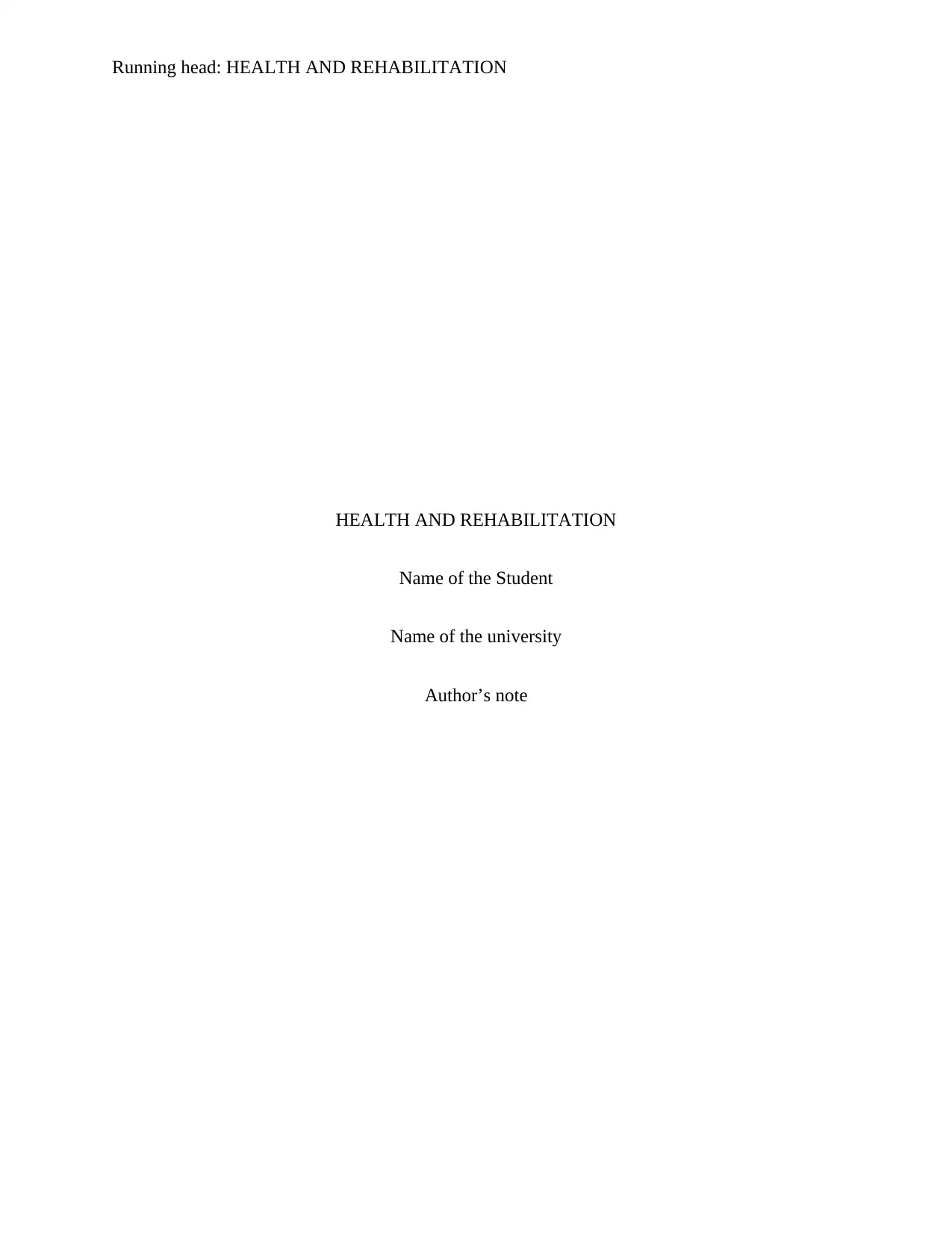
Running head: HEALTH AND REHABILITATION
HEALTH AND REHABILITATION
Name of the Student
Name of the university
Author’s note
HEALTH AND REHABILITATION
Name of the Student
Name of the university
Author’s note
Paraphrase This Document
Need a fresh take? Get an instant paraphrase of this document with our AI Paraphraser
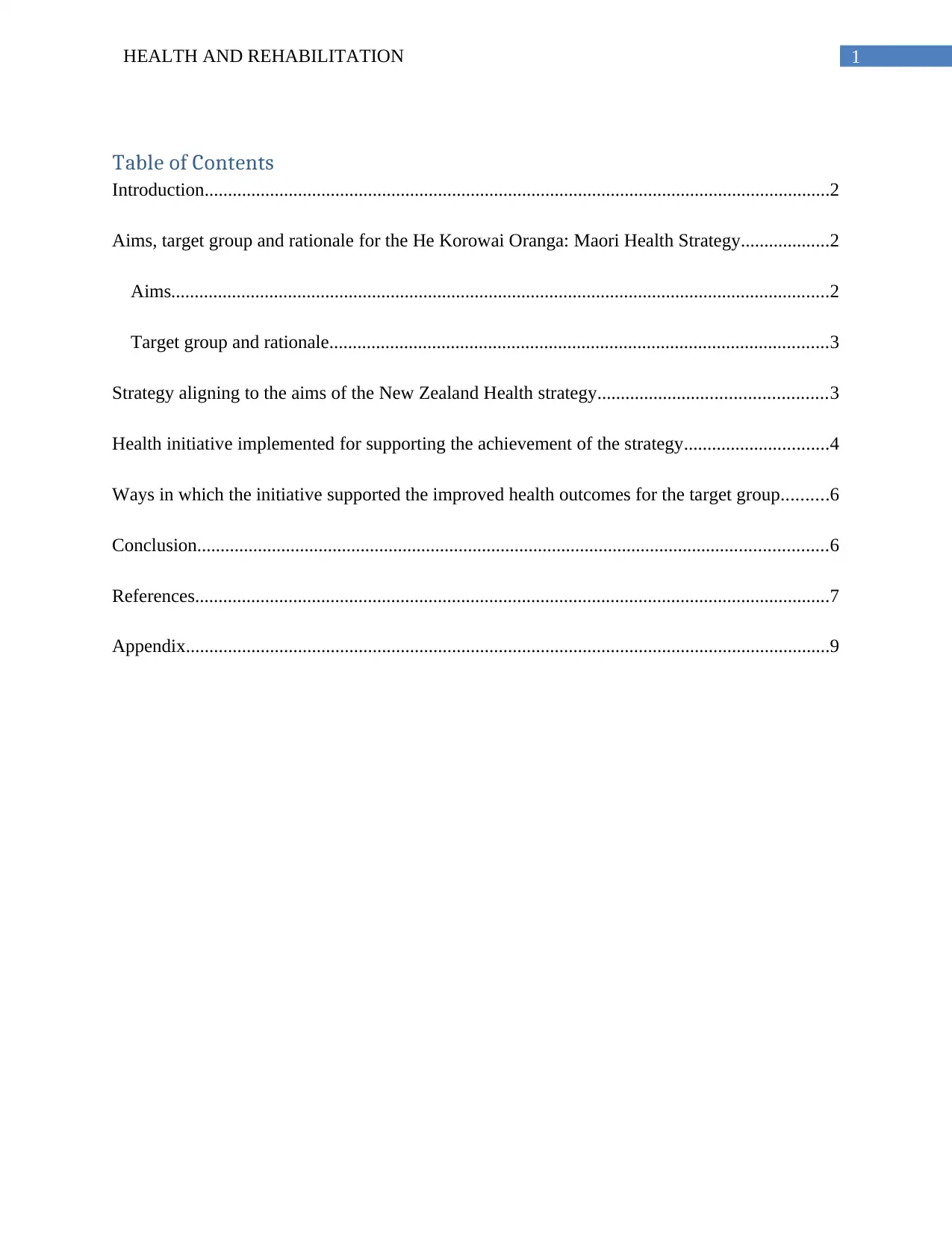
1HEALTH AND REHABILITATION
Table of Contents
Introduction......................................................................................................................................2
Aims, target group and rationale for the He Korowai Oranga: Maori Health Strategy...................2
Aims.............................................................................................................................................2
Target group and rationale...........................................................................................................3
Strategy aligning to the aims of the New Zealand Health strategy.................................................3
Health initiative implemented for supporting the achievement of the strategy...............................4
Ways in which the initiative supported the improved health outcomes for the target group..........6
Conclusion.......................................................................................................................................6
References........................................................................................................................................7
Appendix..........................................................................................................................................9
Table of Contents
Introduction......................................................................................................................................2
Aims, target group and rationale for the He Korowai Oranga: Maori Health Strategy...................2
Aims.............................................................................................................................................2
Target group and rationale...........................................................................................................3
Strategy aligning to the aims of the New Zealand Health strategy.................................................3
Health initiative implemented for supporting the achievement of the strategy...............................4
Ways in which the initiative supported the improved health outcomes for the target group..........6
Conclusion.......................................................................................................................................6
References........................................................................................................................................7
Appendix..........................................................................................................................................9
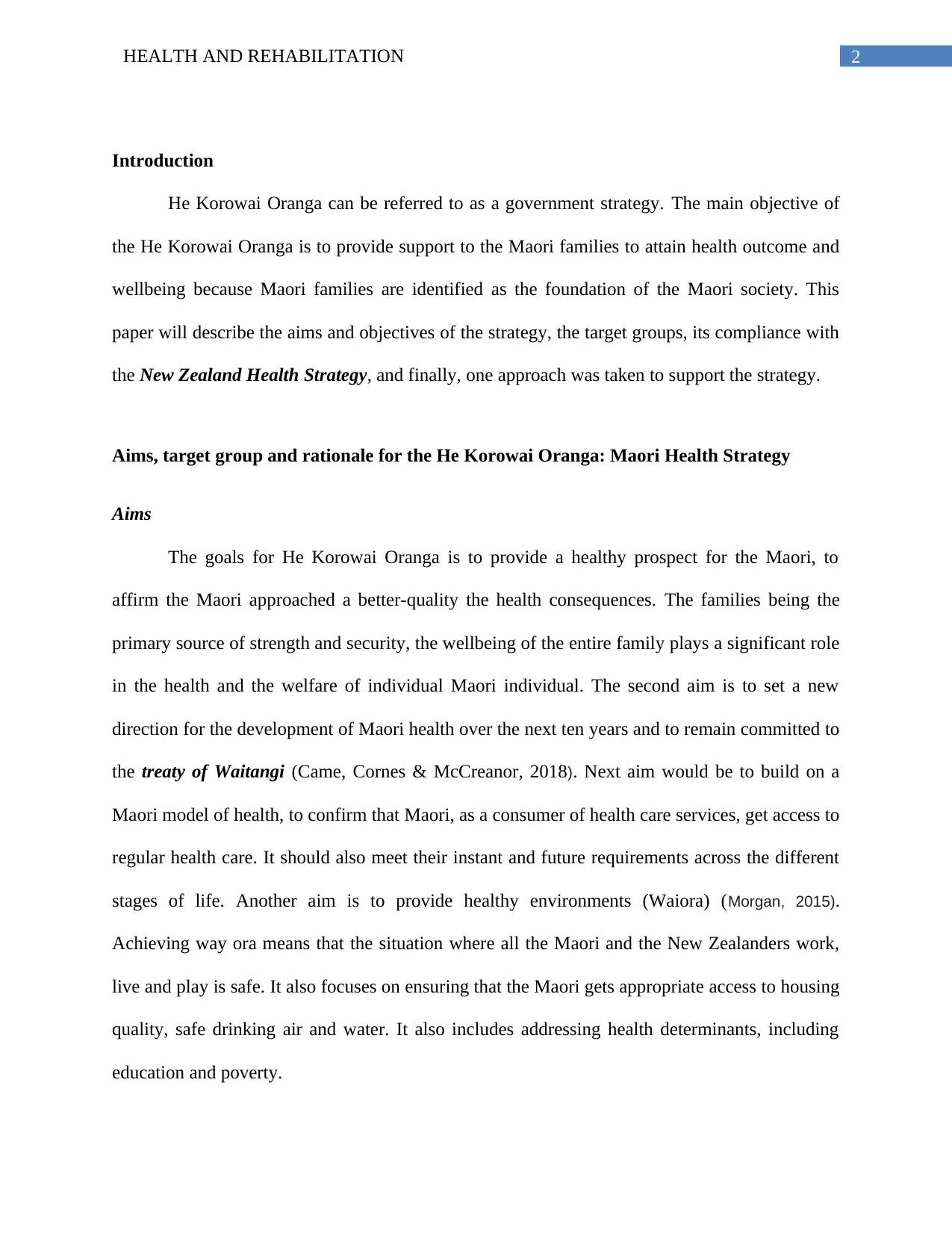
2HEALTH AND REHABILITATION
Introduction
He Korowai Oranga can be referred to as a government strategy. The main objective of
the He Korowai Oranga is to provide support to the Maori families to attain health outcome and
wellbeing because Maori families are identified as the foundation of the Maori society. This
paper will describe the aims and objectives of the strategy, the target groups, its compliance with
the New Zealand Health Strategy, and finally, one approach was taken to support the strategy.
Aims, target group and rationale for the He Korowai Oranga: Maori Health Strategy
Aims
The goals for He Korowai Oranga is to provide a healthy prospect for the Maori, to
affirm the Maori approached a better-quality the health consequences. The families being the
primary source of strength and security, the wellbeing of the entire family plays a significant role
in the health and the welfare of individual Maori individual. The second aim is to set a new
direction for the development of Maori health over the next ten years and to remain committed to
the treaty of Waitangi (Came, Cornes & McCreanor, 2018). Next aim would be to build on a
Maori model of health, to confirm that Maori, as a consumer of health care services, get access to
regular health care. It should also meet their instant and future requirements across the different
stages of life. Another aim is to provide healthy environments (Waiora) (Morgan, 2015).
Achieving way ora means that the situation where all the Maori and the New Zealanders work,
live and play is safe. It also focuses on ensuring that the Maori gets appropriate access to housing
quality, safe drinking air and water. It also includes addressing health determinants, including
education and poverty.
Introduction
He Korowai Oranga can be referred to as a government strategy. The main objective of
the He Korowai Oranga is to provide support to the Maori families to attain health outcome and
wellbeing because Maori families are identified as the foundation of the Maori society. This
paper will describe the aims and objectives of the strategy, the target groups, its compliance with
the New Zealand Health Strategy, and finally, one approach was taken to support the strategy.
Aims, target group and rationale for the He Korowai Oranga: Maori Health Strategy
Aims
The goals for He Korowai Oranga is to provide a healthy prospect for the Maori, to
affirm the Maori approached a better-quality the health consequences. The families being the
primary source of strength and security, the wellbeing of the entire family plays a significant role
in the health and the welfare of individual Maori individual. The second aim is to set a new
direction for the development of Maori health over the next ten years and to remain committed to
the treaty of Waitangi (Came, Cornes & McCreanor, 2018). Next aim would be to build on a
Maori model of health, to confirm that Maori, as a consumer of health care services, get access to
regular health care. It should also meet their instant and future requirements across the different
stages of life. Another aim is to provide healthy environments (Waiora) (Morgan, 2015).
Achieving way ora means that the situation where all the Maori and the New Zealanders work,
live and play is safe. It also focuses on ensuring that the Maori gets appropriate access to housing
quality, safe drinking air and water. It also includes addressing health determinants, including
education and poverty.
⊘ This is a preview!⊘
Do you want full access?
Subscribe today to unlock all pages.

Trusted by 1+ million students worldwide
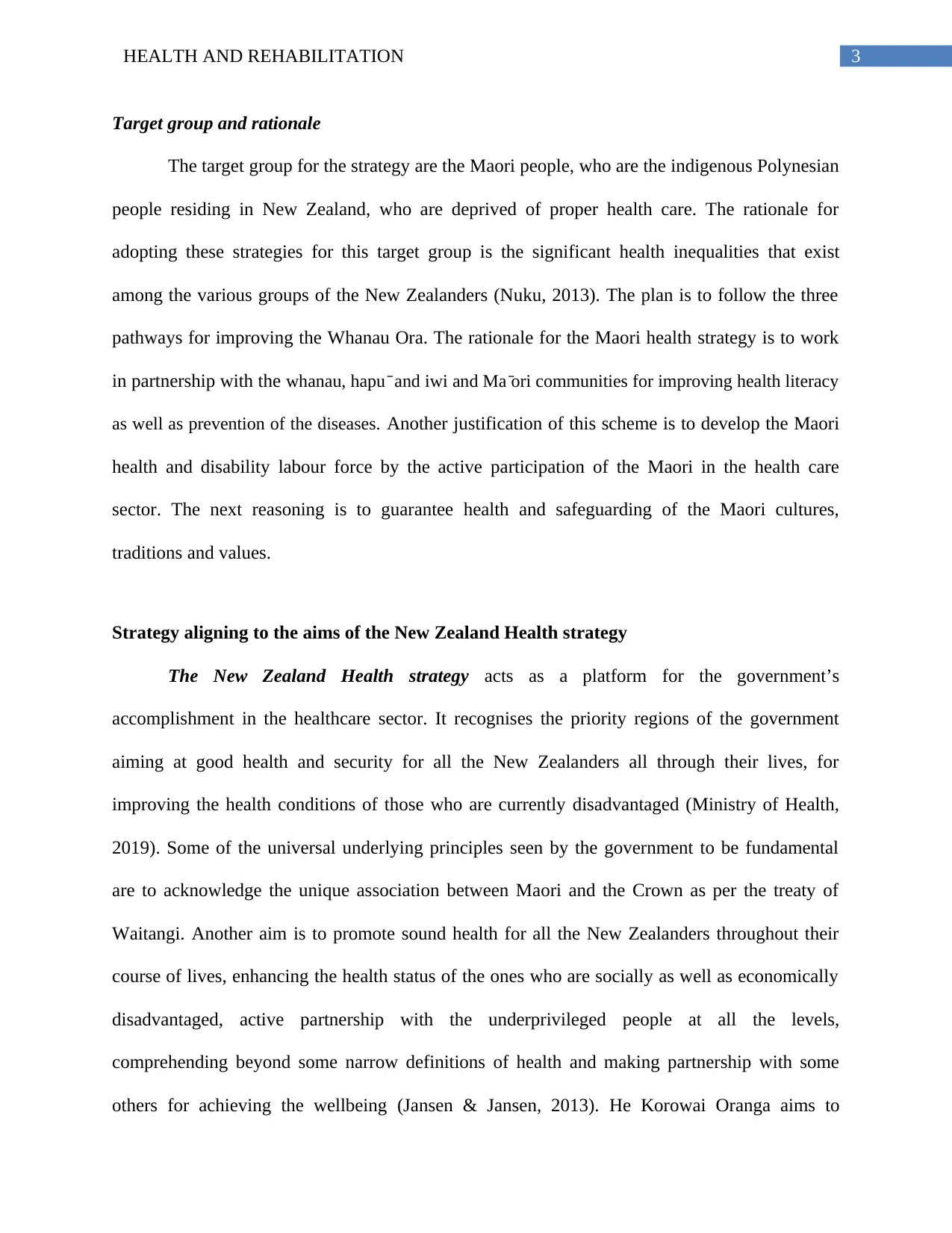
3HEALTH AND REHABILITATION
Target group and rationale
The target group for the strategy are the Maori people, who are the indigenous Polynesian
people residing in New Zealand, who are deprived of proper health care. The rationale for
adopting these strategies for this target group is the significant health inequalities that exist
among the various groups of the New Zealanders (Nuku, 2013). The plan is to follow the three
pathways for improving the Whanau Ora. The rationale for the Maori health strategy is to work
in partnership with the whanau, hapu ̄ and iwi and Ma ̄ ori communities for improving health literacy
as well as prevention of the diseases. Another justification of this scheme is to develop the Maori
health and disability labour force by the active participation of the Maori in the health care
sector. The next reasoning is to guarantee health and safeguarding of the Maori cultures,
traditions and values.
Strategy aligning to the aims of the New Zealand Health strategy
The New Zealand Health strategy acts as a platform for the government’s
accomplishment in the healthcare sector. It recognises the priority regions of the government
aiming at good health and security for all the New Zealanders all through their lives, for
improving the health conditions of those who are currently disadvantaged (Ministry of Health,
2019). Some of the universal underlying principles seen by the government to be fundamental
are to acknowledge the unique association between Maori and the Crown as per the treaty of
Waitangi. Another aim is to promote sound health for all the New Zealanders throughout their
course of lives, enhancing the health status of the ones who are socially as well as economically
disadvantaged, active partnership with the underprivileged people at all the levels,
comprehending beyond some narrow definitions of health and making partnership with some
others for achieving the wellbeing (Jansen & Jansen, 2013). He Korowai Oranga aims to
Target group and rationale
The target group for the strategy are the Maori people, who are the indigenous Polynesian
people residing in New Zealand, who are deprived of proper health care. The rationale for
adopting these strategies for this target group is the significant health inequalities that exist
among the various groups of the New Zealanders (Nuku, 2013). The plan is to follow the three
pathways for improving the Whanau Ora. The rationale for the Maori health strategy is to work
in partnership with the whanau, hapu ̄ and iwi and Ma ̄ ori communities for improving health literacy
as well as prevention of the diseases. Another justification of this scheme is to develop the Maori
health and disability labour force by the active participation of the Maori in the health care
sector. The next reasoning is to guarantee health and safeguarding of the Maori cultures,
traditions and values.
Strategy aligning to the aims of the New Zealand Health strategy
The New Zealand Health strategy acts as a platform for the government’s
accomplishment in the healthcare sector. It recognises the priority regions of the government
aiming at good health and security for all the New Zealanders all through their lives, for
improving the health conditions of those who are currently disadvantaged (Ministry of Health,
2019). Some of the universal underlying principles seen by the government to be fundamental
are to acknowledge the unique association between Maori and the Crown as per the treaty of
Waitangi. Another aim is to promote sound health for all the New Zealanders throughout their
course of lives, enhancing the health status of the ones who are socially as well as economically
disadvantaged, active partnership with the underprivileged people at all the levels,
comprehending beyond some narrow definitions of health and making partnership with some
others for achieving the wellbeing (Jansen & Jansen, 2013). He Korowai Oranga aims to
Paraphrase This Document
Need a fresh take? Get an instant paraphrase of this document with our AI Paraphraser
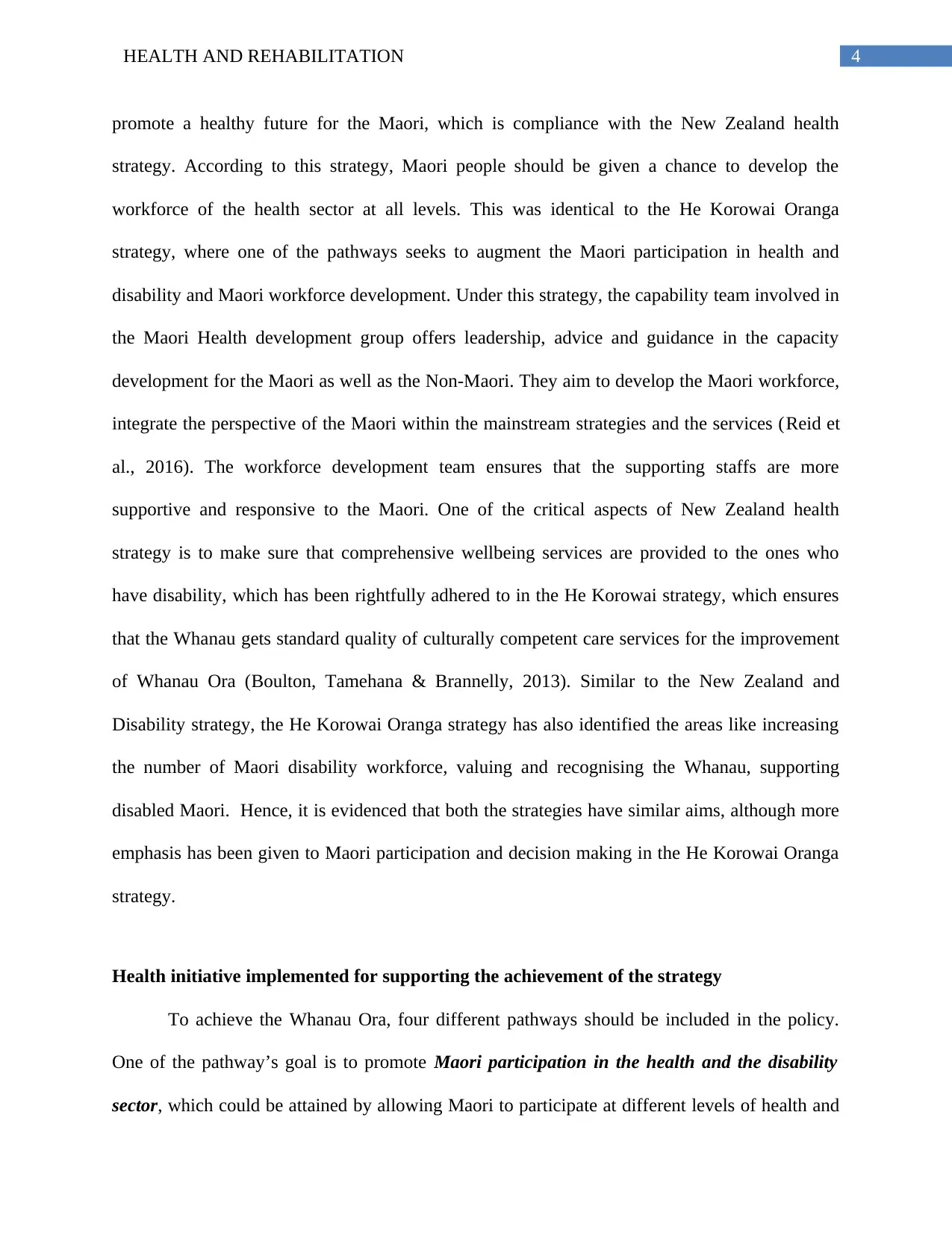
4HEALTH AND REHABILITATION
promote a healthy future for the Maori, which is compliance with the New Zealand health
strategy. According to this strategy, Maori people should be given a chance to develop the
workforce of the health sector at all levels. This was identical to the He Korowai Oranga
strategy, where one of the pathways seeks to augment the Maori participation in health and
disability and Maori workforce development. Under this strategy, the capability team involved in
the Maori Health development group offers leadership, advice and guidance in the capacity
development for the Maori as well as the Non-Maori. They aim to develop the Maori workforce,
integrate the perspective of the Maori within the mainstream strategies and the services (Reid et
al., 2016). The workforce development team ensures that the supporting staffs are more
supportive and responsive to the Maori. One of the critical aspects of New Zealand health
strategy is to make sure that comprehensive wellbeing services are provided to the ones who
have disability, which has been rightfully adhered to in the He Korowai strategy, which ensures
that the Whanau gets standard quality of culturally competent care services for the improvement
of Whanau Ora (Boulton, Tamehana & Brannelly, 2013). Similar to the New Zealand and
Disability strategy, the He Korowai Oranga strategy has also identified the areas like increasing
the number of Maori disability workforce, valuing and recognising the Whanau, supporting
disabled Maori. Hence, it is evidenced that both the strategies have similar aims, although more
emphasis has been given to Maori participation and decision making in the He Korowai Oranga
strategy.
Health initiative implemented for supporting the achievement of the strategy
To achieve the Whanau Ora, four different pathways should be included in the policy.
One of the pathway’s goal is to promote Maori participation in the health and the disability
sector, which could be attained by allowing Maori to participate at different levels of health and
promote a healthy future for the Maori, which is compliance with the New Zealand health
strategy. According to this strategy, Maori people should be given a chance to develop the
workforce of the health sector at all levels. This was identical to the He Korowai Oranga
strategy, where one of the pathways seeks to augment the Maori participation in health and
disability and Maori workforce development. Under this strategy, the capability team involved in
the Maori Health development group offers leadership, advice and guidance in the capacity
development for the Maori as well as the Non-Maori. They aim to develop the Maori workforce,
integrate the perspective of the Maori within the mainstream strategies and the services (Reid et
al., 2016). The workforce development team ensures that the supporting staffs are more
supportive and responsive to the Maori. One of the critical aspects of New Zealand health
strategy is to make sure that comprehensive wellbeing services are provided to the ones who
have disability, which has been rightfully adhered to in the He Korowai strategy, which ensures
that the Whanau gets standard quality of culturally competent care services for the improvement
of Whanau Ora (Boulton, Tamehana & Brannelly, 2013). Similar to the New Zealand and
Disability strategy, the He Korowai Oranga strategy has also identified the areas like increasing
the number of Maori disability workforce, valuing and recognising the Whanau, supporting
disabled Maori. Hence, it is evidenced that both the strategies have similar aims, although more
emphasis has been given to Maori participation and decision making in the He Korowai Oranga
strategy.
Health initiative implemented for supporting the achievement of the strategy
To achieve the Whanau Ora, four different pathways should be included in the policy.
One of the pathway’s goal is to promote Maori participation in the health and the disability
sector, which could be attained by allowing Maori to participate at different levels of health and
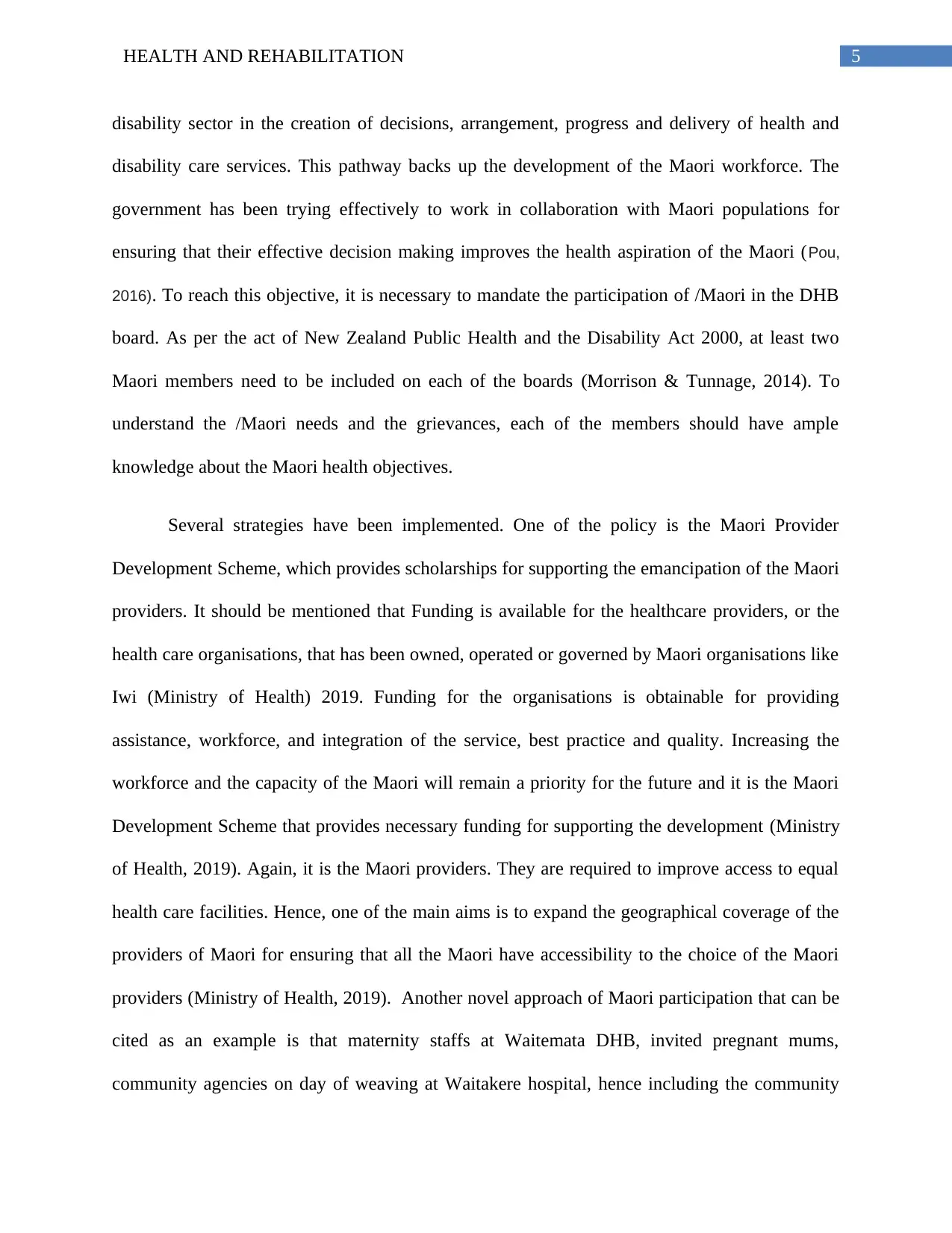
5HEALTH AND REHABILITATION
disability sector in the creation of decisions, arrangement, progress and delivery of health and
disability care services. This pathway backs up the development of the Maori workforce. The
government has been trying effectively to work in collaboration with Maori populations for
ensuring that their effective decision making improves the health aspiration of the Maori (Pou,
2016). To reach this objective, it is necessary to mandate the participation of /Maori in the DHB
board. As per the act of New Zealand Public Health and the Disability Act 2000, at least two
Maori members need to be included on each of the boards (Morrison & Tunnage, 2014). To
understand the /Maori needs and the grievances, each of the members should have ample
knowledge about the Maori health objectives.
Several strategies have been implemented. One of the policy is the Maori Provider
Development Scheme, which provides scholarships for supporting the emancipation of the Maori
providers. It should be mentioned that Funding is available for the healthcare providers, or the
health care organisations, that has been owned, operated or governed by Maori organisations like
Iwi (Ministry of Health) 2019. Funding for the organisations is obtainable for providing
assistance, workforce, and integration of the service, best practice and quality. Increasing the
workforce and the capacity of the Maori will remain a priority for the future and it is the Maori
Development Scheme that provides necessary funding for supporting the development (Ministry
of Health, 2019). Again, it is the Maori providers. They are required to improve access to equal
health care facilities. Hence, one of the main aims is to expand the geographical coverage of the
providers of Maori for ensuring that all the Maori have accessibility to the choice of the Maori
providers (Ministry of Health, 2019). Another novel approach of Maori participation that can be
cited as an example is that maternity staffs at Waitemata DHB, invited pregnant mums,
community agencies on day of weaving at Waitakere hospital, hence including the community
disability sector in the creation of decisions, arrangement, progress and delivery of health and
disability care services. This pathway backs up the development of the Maori workforce. The
government has been trying effectively to work in collaboration with Maori populations for
ensuring that their effective decision making improves the health aspiration of the Maori (Pou,
2016). To reach this objective, it is necessary to mandate the participation of /Maori in the DHB
board. As per the act of New Zealand Public Health and the Disability Act 2000, at least two
Maori members need to be included on each of the boards (Morrison & Tunnage, 2014). To
understand the /Maori needs and the grievances, each of the members should have ample
knowledge about the Maori health objectives.
Several strategies have been implemented. One of the policy is the Maori Provider
Development Scheme, which provides scholarships for supporting the emancipation of the Maori
providers. It should be mentioned that Funding is available for the healthcare providers, or the
health care organisations, that has been owned, operated or governed by Maori organisations like
Iwi (Ministry of Health) 2019. Funding for the organisations is obtainable for providing
assistance, workforce, and integration of the service, best practice and quality. Increasing the
workforce and the capacity of the Maori will remain a priority for the future and it is the Maori
Development Scheme that provides necessary funding for supporting the development (Ministry
of Health, 2019). Again, it is the Maori providers. They are required to improve access to equal
health care facilities. Hence, one of the main aims is to expand the geographical coverage of the
providers of Maori for ensuring that all the Maori have accessibility to the choice of the Maori
providers (Ministry of Health, 2019). Another novel approach of Maori participation that can be
cited as an example is that maternity staffs at Waitemata DHB, invited pregnant mums,
community agencies on day of weaving at Waitakere hospital, hence including the community
⊘ This is a preview!⊘
Do you want full access?
Subscribe today to unlock all pages.

Trusted by 1+ million students worldwide
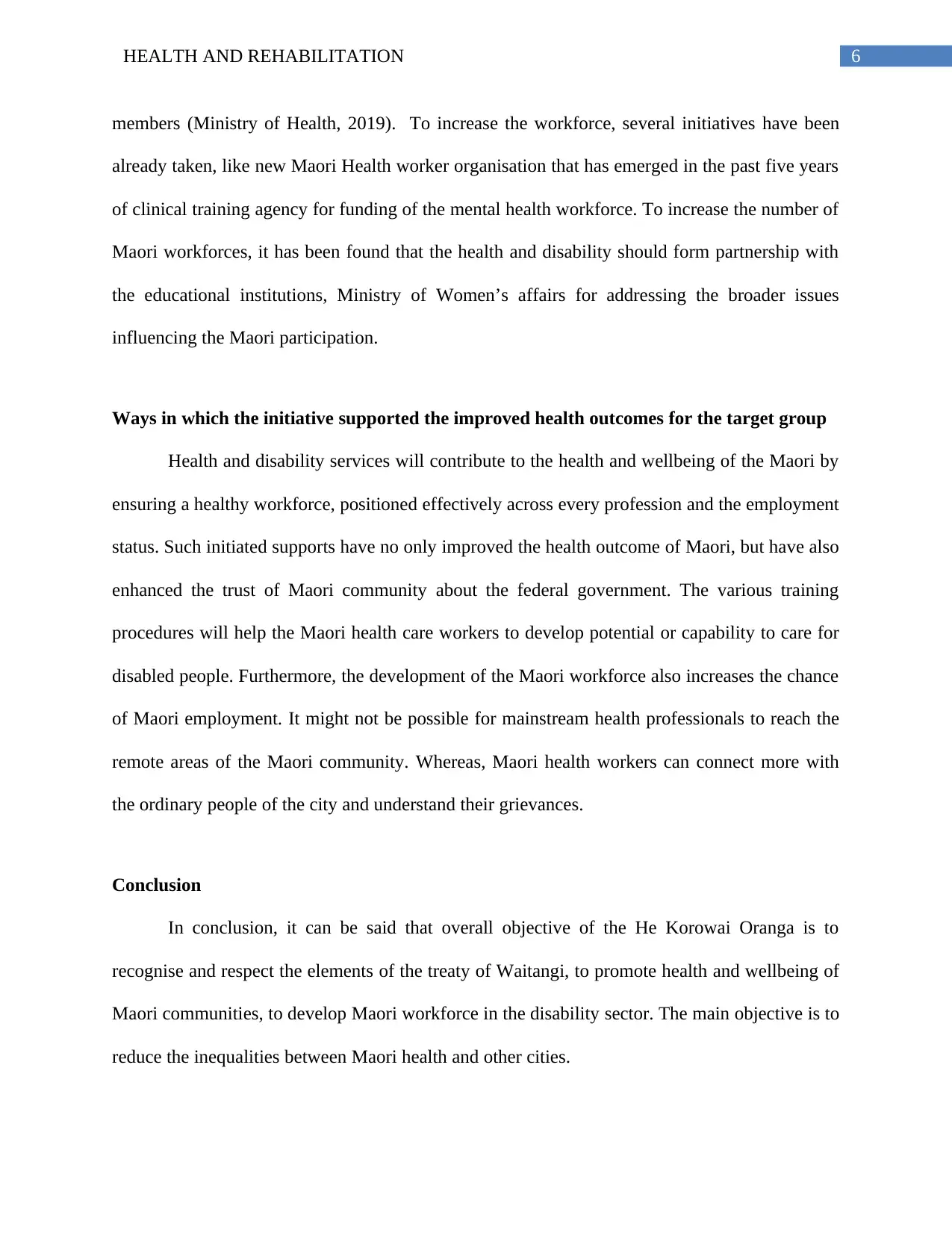
6HEALTH AND REHABILITATION
members (Ministry of Health, 2019). To increase the workforce, several initiatives have been
already taken, like new Maori Health worker organisation that has emerged in the past five years
of clinical training agency for funding of the mental health workforce. To increase the number of
Maori workforces, it has been found that the health and disability should form partnership with
the educational institutions, Ministry of Women’s affairs for addressing the broader issues
influencing the Maori participation.
Ways in which the initiative supported the improved health outcomes for the target group
Health and disability services will contribute to the health and wellbeing of the Maori by
ensuring a healthy workforce, positioned effectively across every profession and the employment
status. Such initiated supports have no only improved the health outcome of Maori, but have also
enhanced the trust of Maori community about the federal government. The various training
procedures will help the Maori health care workers to develop potential or capability to care for
disabled people. Furthermore, the development of the Maori workforce also increases the chance
of Maori employment. It might not be possible for mainstream health professionals to reach the
remote areas of the Maori community. Whereas, Maori health workers can connect more with
the ordinary people of the city and understand their grievances.
Conclusion
In conclusion, it can be said that overall objective of the He Korowai Oranga is to
recognise and respect the elements of the treaty of Waitangi, to promote health and wellbeing of
Maori communities, to develop Maori workforce in the disability sector. The main objective is to
reduce the inequalities between Maori health and other cities.
members (Ministry of Health, 2019). To increase the workforce, several initiatives have been
already taken, like new Maori Health worker organisation that has emerged in the past five years
of clinical training agency for funding of the mental health workforce. To increase the number of
Maori workforces, it has been found that the health and disability should form partnership with
the educational institutions, Ministry of Women’s affairs for addressing the broader issues
influencing the Maori participation.
Ways in which the initiative supported the improved health outcomes for the target group
Health and disability services will contribute to the health and wellbeing of the Maori by
ensuring a healthy workforce, positioned effectively across every profession and the employment
status. Such initiated supports have no only improved the health outcome of Maori, but have also
enhanced the trust of Maori community about the federal government. The various training
procedures will help the Maori health care workers to develop potential or capability to care for
disabled people. Furthermore, the development of the Maori workforce also increases the chance
of Maori employment. It might not be possible for mainstream health professionals to reach the
remote areas of the Maori community. Whereas, Maori health workers can connect more with
the ordinary people of the city and understand their grievances.
Conclusion
In conclusion, it can be said that overall objective of the He Korowai Oranga is to
recognise and respect the elements of the treaty of Waitangi, to promote health and wellbeing of
Maori communities, to develop Maori workforce in the disability sector. The main objective is to
reduce the inequalities between Maori health and other cities.
Paraphrase This Document
Need a fresh take? Get an instant paraphrase of this document with our AI Paraphraser
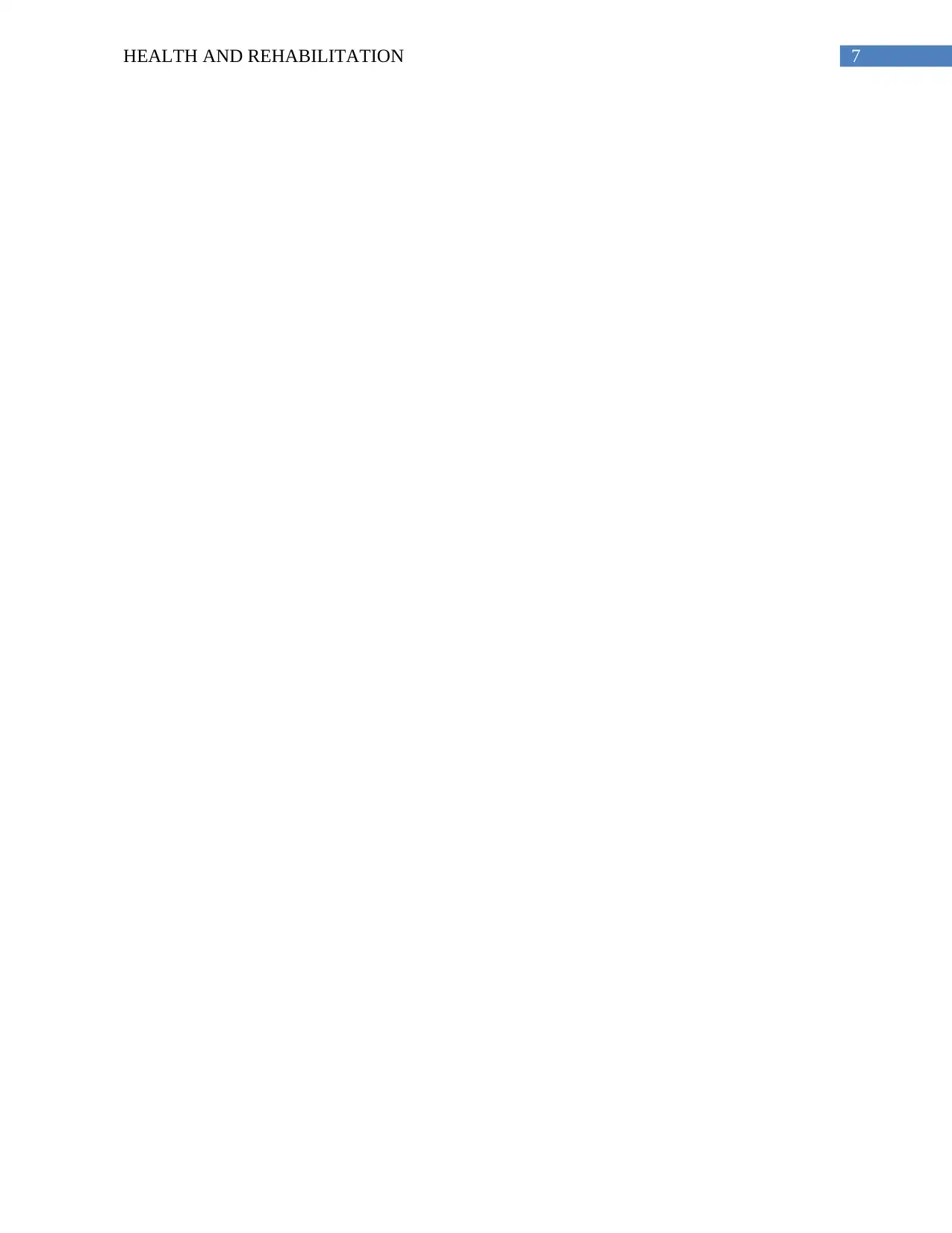
7HEALTH AND REHABILITATION
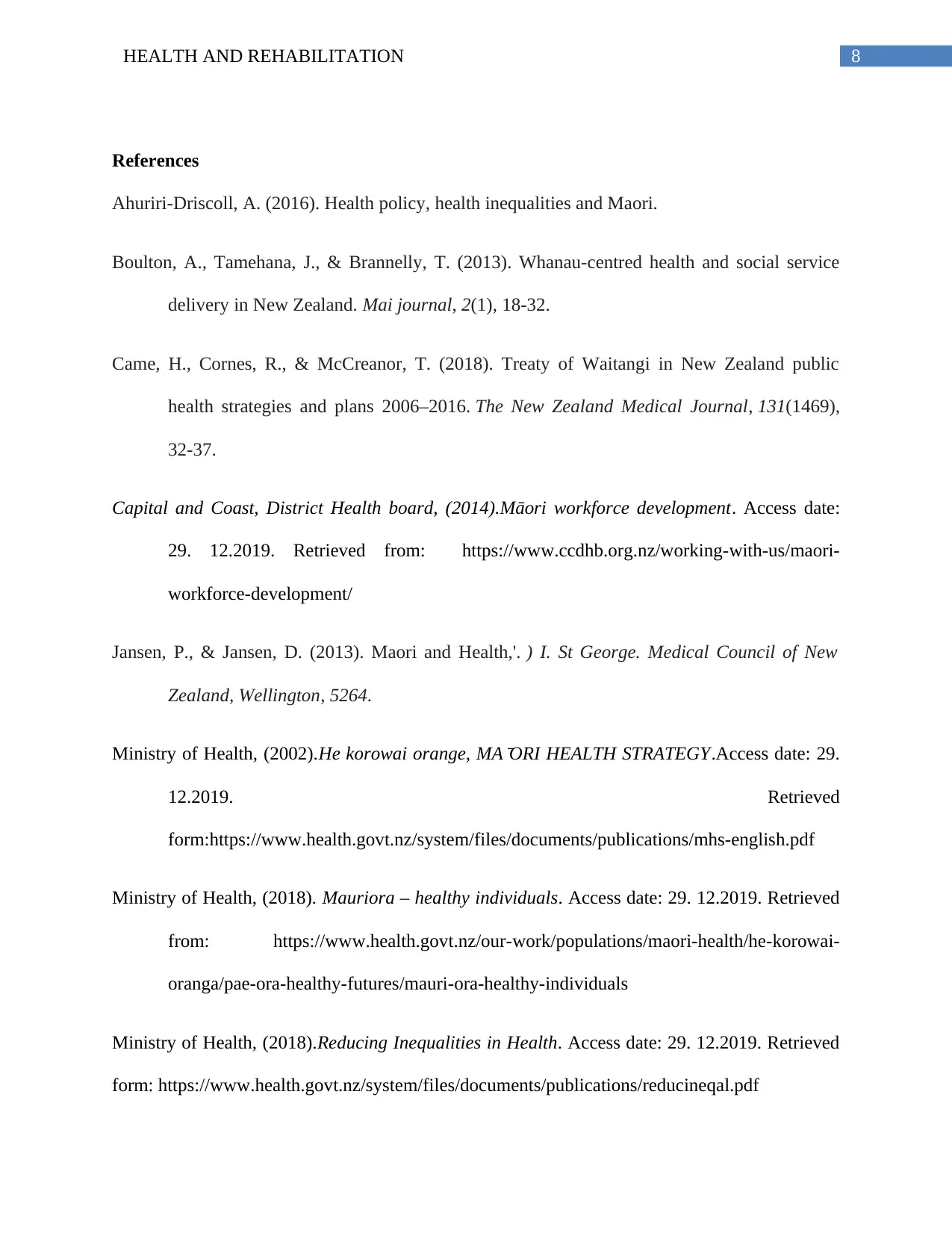
8HEALTH AND REHABILITATION
References
Ahuriri-Driscoll, A. (2016). Health policy, health inequalities and Maori.
Boulton, A., Tamehana, J., & Brannelly, T. (2013). Whanau-centred health and social service
delivery in New Zealand. Mai journal, 2(1), 18-32.
Came, H., Cornes, R., & McCreanor, T. (2018). Treaty of Waitangi in New Zealand public
health strategies and plans 2006–2016. The New Zealand Medical Journal, 131(1469),
32-37.
Capital and Coast, District Health board, (2014).Māori workforce development. Access date:
29. 12.2019. Retrieved from: https://www.ccdhb.org.nz/working-with-us/maori-
workforce-development/
Jansen, P., & Jansen, D. (2013). Maori and Health,'. ) I. St George. Medical Council of New
Zealand, Wellington, 5264.
Ministry of Health, (2002).He korowai orange, MA ̄ ORI HEALTH STRATEGY.Access date: 29.
12.2019. Retrieved
form:https://www.health.govt.nz/system/files/documents/publications/mhs-english.pdf
Ministry of Health, (2018). Mauriora – healthy individuals. Access date: 29. 12.2019. Retrieved
from: https://www.health.govt.nz/our-work/populations/maori-health/he-korowai-
oranga/pae-ora-healthy-futures/mauri-ora-healthy-individuals
Ministry of Health, (2018).Reducing Inequalities in Health. Access date: 29. 12.2019. Retrieved
form: https://www.health.govt.nz/system/files/documents/publications/reducineqal.pdf
References
Ahuriri-Driscoll, A. (2016). Health policy, health inequalities and Maori.
Boulton, A., Tamehana, J., & Brannelly, T. (2013). Whanau-centred health and social service
delivery in New Zealand. Mai journal, 2(1), 18-32.
Came, H., Cornes, R., & McCreanor, T. (2018). Treaty of Waitangi in New Zealand public
health strategies and plans 2006–2016. The New Zealand Medical Journal, 131(1469),
32-37.
Capital and Coast, District Health board, (2014).Māori workforce development. Access date:
29. 12.2019. Retrieved from: https://www.ccdhb.org.nz/working-with-us/maori-
workforce-development/
Jansen, P., & Jansen, D. (2013). Maori and Health,'. ) I. St George. Medical Council of New
Zealand, Wellington, 5264.
Ministry of Health, (2002).He korowai orange, MA ̄ ORI HEALTH STRATEGY.Access date: 29.
12.2019. Retrieved
form:https://www.health.govt.nz/system/files/documents/publications/mhs-english.pdf
Ministry of Health, (2018). Mauriora – healthy individuals. Access date: 29. 12.2019. Retrieved
from: https://www.health.govt.nz/our-work/populations/maori-health/he-korowai-
oranga/pae-ora-healthy-futures/mauri-ora-healthy-individuals
Ministry of Health, (2018).Reducing Inequalities in Health. Access date: 29. 12.2019. Retrieved
form: https://www.health.govt.nz/system/files/documents/publications/reducineqal.pdf
⊘ This is a preview!⊘
Do you want full access?
Subscribe today to unlock all pages.

Trusted by 1+ million students worldwide
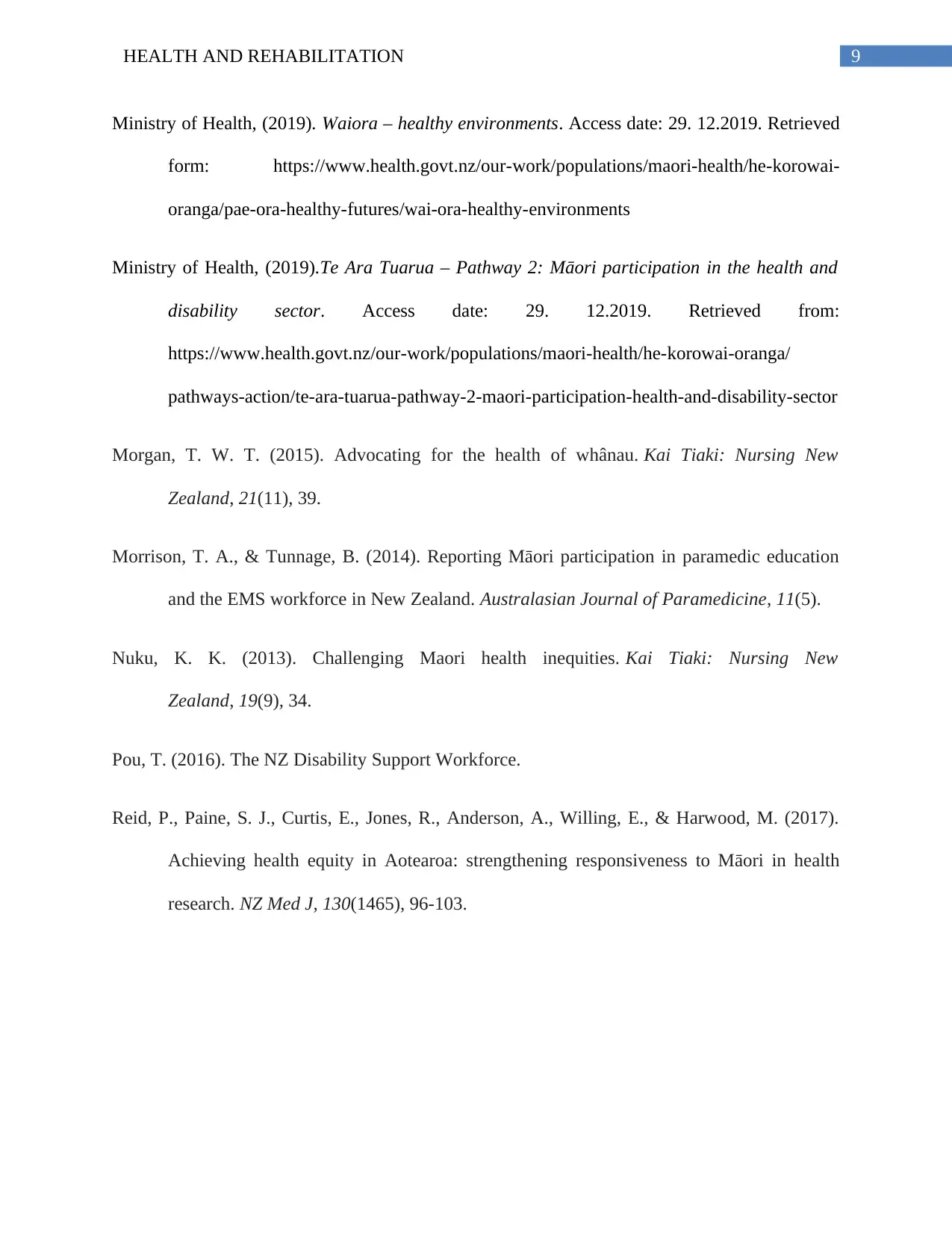
9HEALTH AND REHABILITATION
Ministry of Health, (2019). Waiora – healthy environments. Access date: 29. 12.2019. Retrieved
form: https://www.health.govt.nz/our-work/populations/maori-health/he-korowai-
oranga/pae-ora-healthy-futures/wai-ora-healthy-environments
Ministry of Health, (2019).Te Ara Tuarua – Pathway 2: Māori participation in the health and
disability sector. Access date: 29. 12.2019. Retrieved from:
https://www.health.govt.nz/our-work/populations/maori-health/he-korowai-oranga/
pathways-action/te-ara-tuarua-pathway-2-maori-participation-health-and-disability-sector
Morgan, T. W. T. (2015). Advocating for the health of whânau. Kai Tiaki: Nursing New
Zealand, 21(11), 39.
Morrison, T. A., & Tunnage, B. (2014). Reporting Māori participation in paramedic education
and the EMS workforce in New Zealand. Australasian Journal of Paramedicine, 11(5).
Nuku, K. K. (2013). Challenging Maori health inequities. Kai Tiaki: Nursing New
Zealand, 19(9), 34.
Pou, T. (2016). The NZ Disability Support Workforce.
Reid, P., Paine, S. J., Curtis, E., Jones, R., Anderson, A., Willing, E., & Harwood, M. (2017).
Achieving health equity in Aotearoa: strengthening responsiveness to Māori in health
research. NZ Med J, 130(1465), 96-103.
Ministry of Health, (2019). Waiora – healthy environments. Access date: 29. 12.2019. Retrieved
form: https://www.health.govt.nz/our-work/populations/maori-health/he-korowai-
oranga/pae-ora-healthy-futures/wai-ora-healthy-environments
Ministry of Health, (2019).Te Ara Tuarua – Pathway 2: Māori participation in the health and
disability sector. Access date: 29. 12.2019. Retrieved from:
https://www.health.govt.nz/our-work/populations/maori-health/he-korowai-oranga/
pathways-action/te-ara-tuarua-pathway-2-maori-participation-health-and-disability-sector
Morgan, T. W. T. (2015). Advocating for the health of whânau. Kai Tiaki: Nursing New
Zealand, 21(11), 39.
Morrison, T. A., & Tunnage, B. (2014). Reporting Māori participation in paramedic education
and the EMS workforce in New Zealand. Australasian Journal of Paramedicine, 11(5).
Nuku, K. K. (2013). Challenging Maori health inequities. Kai Tiaki: Nursing New
Zealand, 19(9), 34.
Pou, T. (2016). The NZ Disability Support Workforce.
Reid, P., Paine, S. J., Curtis, E., Jones, R., Anderson, A., Willing, E., & Harwood, M. (2017).
Achieving health equity in Aotearoa: strengthening responsiveness to Māori in health
research. NZ Med J, 130(1465), 96-103.
Paraphrase This Document
Need a fresh take? Get an instant paraphrase of this document with our AI Paraphraser
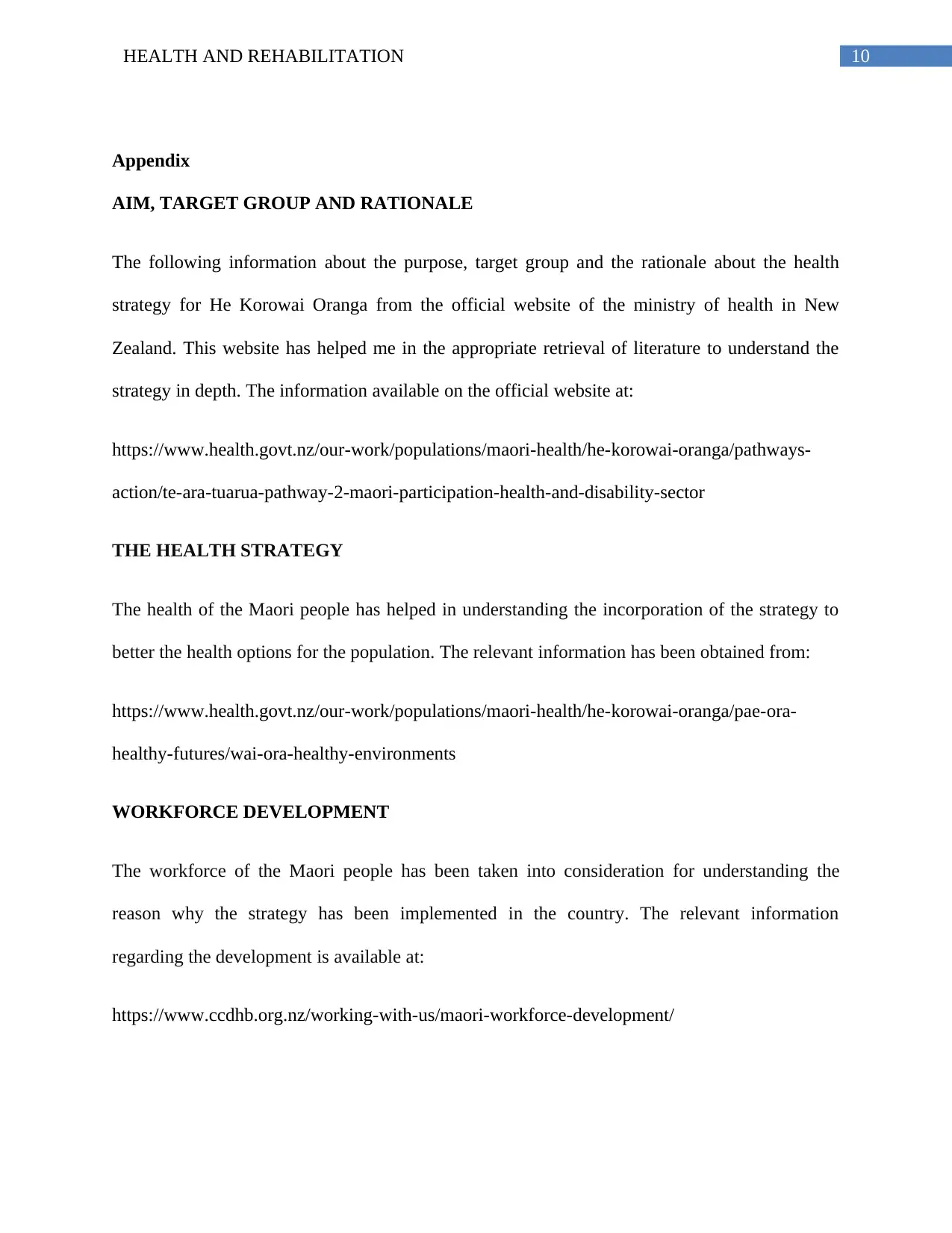
10HEALTH AND REHABILITATION
Appendix
AIM, TARGET GROUP AND RATIONALE
The following information about the purpose, target group and the rationale about the health
strategy for He Korowai Oranga from the official website of the ministry of health in New
Zealand. This website has helped me in the appropriate retrieval of literature to understand the
strategy in depth. The information available on the official website at:
https://www.health.govt.nz/our-work/populations/maori-health/he-korowai-oranga/pathways-
action/te-ara-tuarua-pathway-2-maori-participation-health-and-disability-sector
THE HEALTH STRATEGY
The health of the Maori people has helped in understanding the incorporation of the strategy to
better the health options for the population. The relevant information has been obtained from:
https://www.health.govt.nz/our-work/populations/maori-health/he-korowai-oranga/pae-ora-
healthy-futures/wai-ora-healthy-environments
WORKFORCE DEVELOPMENT
The workforce of the Maori people has been taken into consideration for understanding the
reason why the strategy has been implemented in the country. The relevant information
regarding the development is available at:
https://www.ccdhb.org.nz/working-with-us/maori-workforce-development/
Appendix
AIM, TARGET GROUP AND RATIONALE
The following information about the purpose, target group and the rationale about the health
strategy for He Korowai Oranga from the official website of the ministry of health in New
Zealand. This website has helped me in the appropriate retrieval of literature to understand the
strategy in depth. The information available on the official website at:
https://www.health.govt.nz/our-work/populations/maori-health/he-korowai-oranga/pathways-
action/te-ara-tuarua-pathway-2-maori-participation-health-and-disability-sector
THE HEALTH STRATEGY
The health of the Maori people has helped in understanding the incorporation of the strategy to
better the health options for the population. The relevant information has been obtained from:
https://www.health.govt.nz/our-work/populations/maori-health/he-korowai-oranga/pae-ora-
healthy-futures/wai-ora-healthy-environments
WORKFORCE DEVELOPMENT
The workforce of the Maori people has been taken into consideration for understanding the
reason why the strategy has been implemented in the country. The relevant information
regarding the development is available at:
https://www.ccdhb.org.nz/working-with-us/maori-workforce-development/
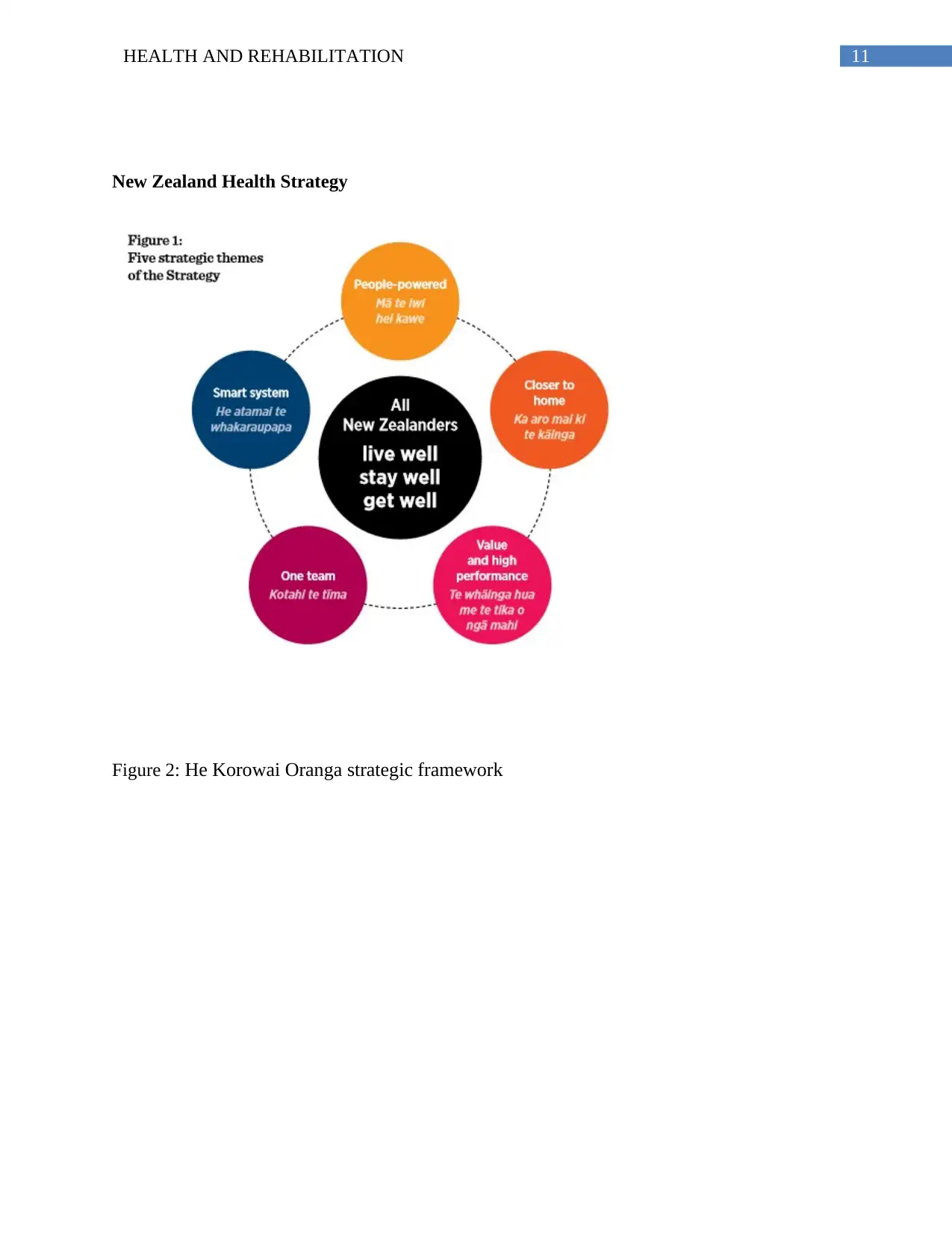
11HEALTH AND REHABILITATION
New Zealand Health Strategy
Figure 2: He Korowai Oranga strategic framework
New Zealand Health Strategy
Figure 2: He Korowai Oranga strategic framework
⊘ This is a preview!⊘
Do you want full access?
Subscribe today to unlock all pages.

Trusted by 1+ million students worldwide
1 out of 13
Related Documents
Your All-in-One AI-Powered Toolkit for Academic Success.
+13062052269
info@desklib.com
Available 24*7 on WhatsApp / Email
![[object Object]](/_next/static/media/star-bottom.7253800d.svg)
Unlock your academic potential
Copyright © 2020–2025 A2Z Services. All Rights Reserved. Developed and managed by ZUCOL.





